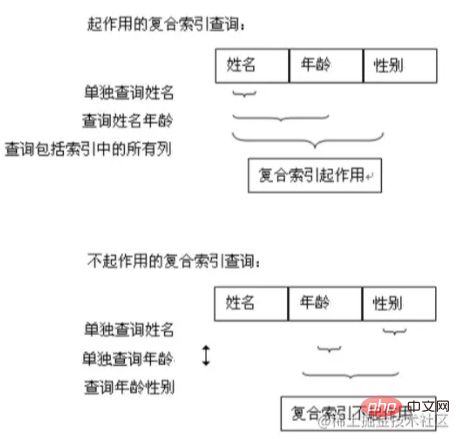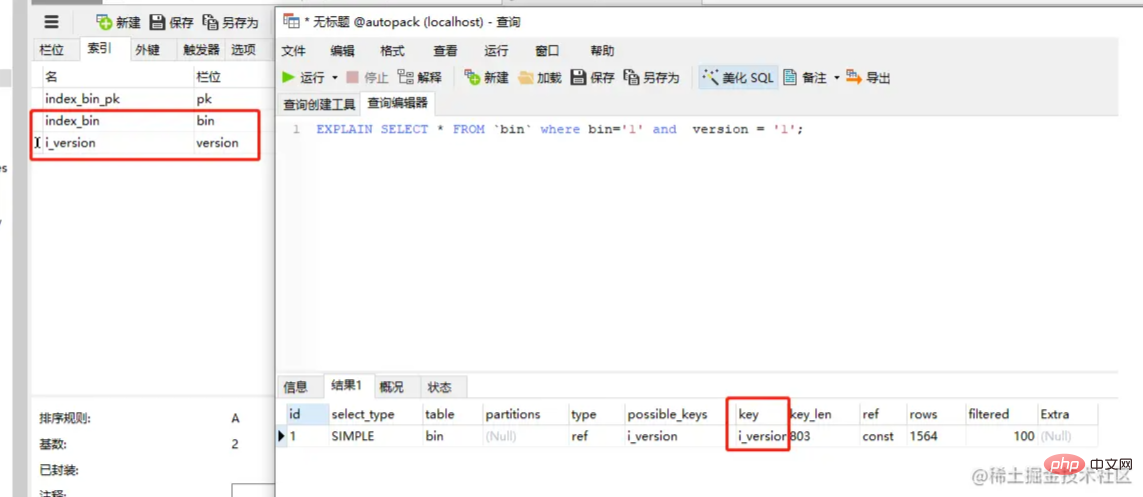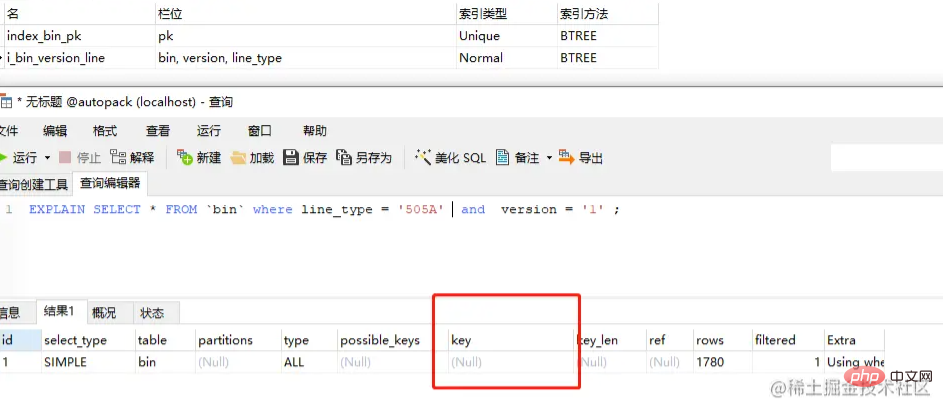 Database
Database
 Mysql Tutorial
Mysql Tutorial
 Get an in-depth understanding of combined indexes in MySQL and see the differences from single-column indexes
Get an in-depth understanding of combined indexes in MySQL and see the differences from single-column indexes
Get an in-depth understanding of combined indexes in MySQL and see the differences from single-column indexes
This article will take you to understand the combined index in MySQL, introduce the method of creating and deleting the combined index, talk about the pitfalls of the combined index, the difference between the combined index and the single column index, and the usage scenarios of the combined index. I hope it will be useful to everyone. help!

What is a composite index
An index on two or more columns is called a joint index, and a joint index is It's called a composite index. [Related recommendations: mysql video tutorial]
For example, the index is key index (a,b,c) which can support a | a,b| a ,b,c 3 combinations are used for search, but b,c is not supported for search. When used, the combination of a, c can also be used, but in fact only the index

-- 普通的组合索引
create index index_name on table_name (column1, column2, ...)
-- 组合要求唯一的索引,相比与上一种,多出了 【unique】关键字
create unique index index_name on table_name (column1, column2, ...)
Copy after login
-- 普通的组合索引 create index index_name on table_name (column1, column2, ...) -- 组合要求唯一的索引,相比与上一种,多出了 【unique】关键字 create unique index index_name on table_name (column1, column2, ...)

-- 用法 1
drop index index_name on talbe_name
-- 用法 2
alter table table_name drop index index_name
-- 用法 3,对 2 的包装
alter table table_name drop primary key
Copy after login
Single column index trap-- 用法 1 drop index index_name on talbe_name -- 用法 2 alter table table_name drop index index_name -- 用法 3,对 2 的包装 alter table table_name drop primary key

 As shown in the figure, we created 2 indexes and used
As shown in the figure, we created 2 indexes and used
in where to query, from execution According to the plan, only the index on the first condition is used, and subsequent indexes are directly ignored.
As shown in the figure, now create a combined index a ,b,c
 The conditional query in the above figure is
The conditional query in the above figure is
, mysql will automatically process the condition sequence into a,b, c , and then use the defined combined index
 The query conditions in the above figure are
The query conditions in the above figure are
. Similarly, mysql adjusts the condition order as a,b, and then use the combined index
 The query condition in the above picture is
The query condition in the above picture is
, obviously, because # is not used ##a As a conditional column, mysql does not use a composite index The difference between a single column index and a single column index
The order of columns in a joint index is very important, from the left principle .
Single indexes work one by one, that is to say, there are three single indexes. Which condition query works first, and the others do not work.Combined index usage scenarios
where conditions will often appear, and the number of current tables is relatively large.
- where When and
- is used in the condition instead of
or
Joint index is more suitable than a single index, because the index occupies a certain amount of disk space, which means there is a certain amount of overhead. If there are more than one single index, the waste of resources will be greater. Many, a joint index is equivalent to building an index on multiple columns, and it is only built once, which is very suitable under and conditions.. - For more programming-related knowledge, please visit: Programming Video
The above is the detailed content of Get an in-depth understanding of combined indexes in MySQL and see the differences from single-column indexes. For more information, please follow other related articles on the PHP Chinese website!

Hot AI Tools

Undresser.AI Undress
AI-powered app for creating realistic nude photos

AI Clothes Remover
Online AI tool for removing clothes from photos.

Undress AI Tool
Undress images for free

Clothoff.io
AI clothes remover

Video Face Swap
Swap faces in any video effortlessly with our completely free AI face swap tool!

Hot Article

Hot Tools

Notepad++7.3.1
Easy-to-use and free code editor

SublimeText3 Chinese version
Chinese version, very easy to use

Zend Studio 13.0.1
Powerful PHP integrated development environment

Dreamweaver CS6
Visual web development tools

SublimeText3 Mac version
God-level code editing software (SublimeText3)

Hot Topics
 1386
1386
 52
52
 MySQL: Simple Concepts for Easy Learning
Apr 10, 2025 am 09:29 AM
MySQL: Simple Concepts for Easy Learning
Apr 10, 2025 am 09:29 AM
MySQL is an open source relational database management system. 1) Create database and tables: Use the CREATEDATABASE and CREATETABLE commands. 2) Basic operations: INSERT, UPDATE, DELETE and SELECT. 3) Advanced operations: JOIN, subquery and transaction processing. 4) Debugging skills: Check syntax, data type and permissions. 5) Optimization suggestions: Use indexes, avoid SELECT* and use transactions.
 How to open phpmyadmin
Apr 10, 2025 pm 10:51 PM
How to open phpmyadmin
Apr 10, 2025 pm 10:51 PM
You can open phpMyAdmin through the following steps: 1. Log in to the website control panel; 2. Find and click the phpMyAdmin icon; 3. Enter MySQL credentials; 4. Click "Login".
 MySQL: An Introduction to the World's Most Popular Database
Apr 12, 2025 am 12:18 AM
MySQL: An Introduction to the World's Most Popular Database
Apr 12, 2025 am 12:18 AM
MySQL is an open source relational database management system, mainly used to store and retrieve data quickly and reliably. Its working principle includes client requests, query resolution, execution of queries and return results. Examples of usage include creating tables, inserting and querying data, and advanced features such as JOIN operations. Common errors involve SQL syntax, data types, and permissions, and optimization suggestions include the use of indexes, optimized queries, and partitioning of tables.
 Why Use MySQL? Benefits and Advantages
Apr 12, 2025 am 12:17 AM
Why Use MySQL? Benefits and Advantages
Apr 12, 2025 am 12:17 AM
MySQL is chosen for its performance, reliability, ease of use, and community support. 1.MySQL provides efficient data storage and retrieval functions, supporting multiple data types and advanced query operations. 2. Adopt client-server architecture and multiple storage engines to support transaction and query optimization. 3. Easy to use, supports a variety of operating systems and programming languages. 4. Have strong community support and provide rich resources and solutions.
 How to use single threaded redis
Apr 10, 2025 pm 07:12 PM
How to use single threaded redis
Apr 10, 2025 pm 07:12 PM
Redis uses a single threaded architecture to provide high performance, simplicity, and consistency. It utilizes I/O multiplexing, event loops, non-blocking I/O, and shared memory to improve concurrency, but with limitations of concurrency limitations, single point of failure, and unsuitable for write-intensive workloads.
 MySQL and SQL: Essential Skills for Developers
Apr 10, 2025 am 09:30 AM
MySQL and SQL: Essential Skills for Developers
Apr 10, 2025 am 09:30 AM
MySQL and SQL are essential skills for developers. 1.MySQL is an open source relational database management system, and SQL is the standard language used to manage and operate databases. 2.MySQL supports multiple storage engines through efficient data storage and retrieval functions, and SQL completes complex data operations through simple statements. 3. Examples of usage include basic queries and advanced queries, such as filtering and sorting by condition. 4. Common errors include syntax errors and performance issues, which can be optimized by checking SQL statements and using EXPLAIN commands. 5. Performance optimization techniques include using indexes, avoiding full table scanning, optimizing JOIN operations and improving code readability.
 MySQL's Place: Databases and Programming
Apr 13, 2025 am 12:18 AM
MySQL's Place: Databases and Programming
Apr 13, 2025 am 12:18 AM
MySQL's position in databases and programming is very important. It is an open source relational database management system that is widely used in various application scenarios. 1) MySQL provides efficient data storage, organization and retrieval functions, supporting Web, mobile and enterprise-level systems. 2) It uses a client-server architecture, supports multiple storage engines and index optimization. 3) Basic usages include creating tables and inserting data, and advanced usages involve multi-table JOINs and complex queries. 4) Frequently asked questions such as SQL syntax errors and performance issues can be debugged through the EXPLAIN command and slow query log. 5) Performance optimization methods include rational use of indexes, optimized query and use of caches. Best practices include using transactions and PreparedStatemen
 Monitor Redis Droplet with Redis Exporter Service
Apr 10, 2025 pm 01:36 PM
Monitor Redis Droplet with Redis Exporter Service
Apr 10, 2025 pm 01:36 PM
Effective monitoring of Redis databases is critical to maintaining optimal performance, identifying potential bottlenecks, and ensuring overall system reliability. Redis Exporter Service is a powerful utility designed to monitor Redis databases using Prometheus. This tutorial will guide you through the complete setup and configuration of Redis Exporter Service, ensuring you seamlessly build monitoring solutions. By studying this tutorial, you will achieve fully operational monitoring settings



